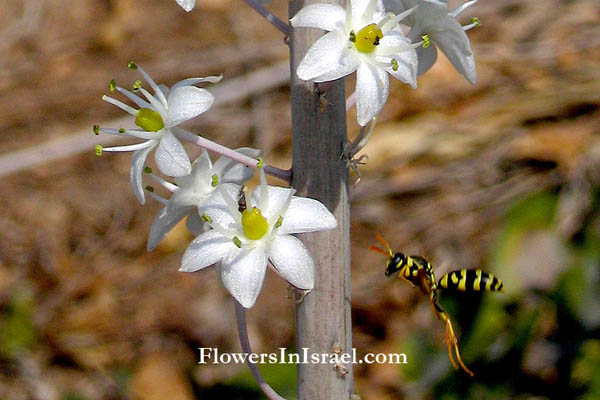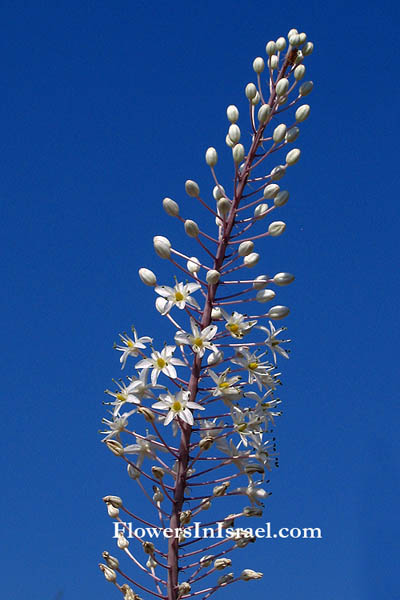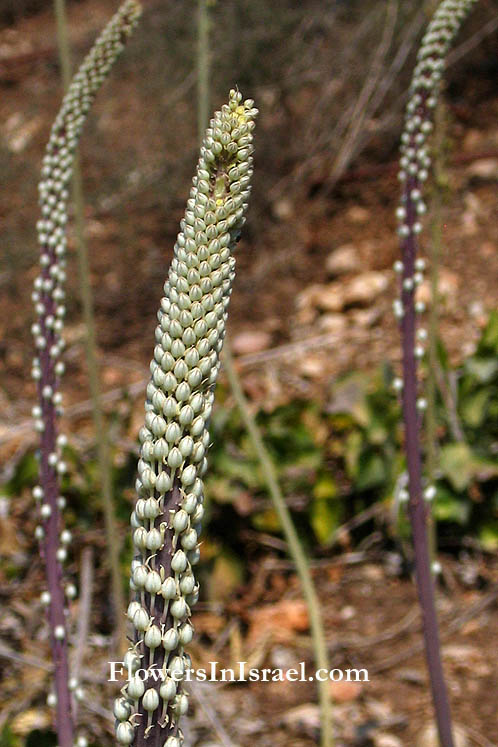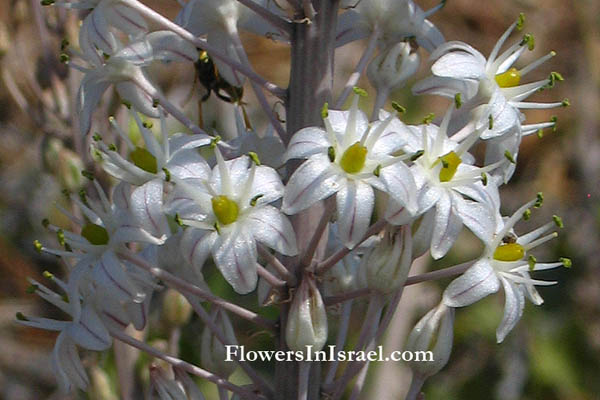Hebrew: חצב מצוי, Arabic: عيصلان
| Scientific name: | Urginea maritima (L.) Baker | |
| Scientific name: | Drimia maritima (L.) Stearn | |
| Common name: | Sea Squill | |
| Hebrew name: | חצב מצוי | |
| Arabic name: | عيصلان | |
| Plant Family: | Liliaceae, שושניים |

|
| Life form: | Geophyte | |
| Stems: | 50-150 cm high | |
| Leaves: | 30-100 cm long, 30-100 mm wide, long-lanceolate, entire, appearing before the flowers | |
| Inflorescence: | Long, dense many flowered raceme; bracts subulate, shorter than the pedicels | |
| Flowers: | Perianth-segments free, oblong, white with a green or purple mid-vein; style equalling the stamens | |
| Fruits / pods: | Follicles open when ripe, each containing one smooth, polished, brown seed; pericarp of the seed is brown and wrinkled below | |
| Flowering Period: | July, August, September, October | |
| Habitat: | Batha, Phrygana | |
| Distribution: | Mediterranean Woodlands and Shrublands, Semi-steppe shrublands, Shrub-steppes, Deserts and extreme deserts, Montane vegetation of Mt. Hermon | |
| Chorotype: | Mediterranean | |
| Summer shedding: | Ephemeral |

Derivation of the botanical name: Urginea, named for an Arabian tribe in Algeria, known as Ben Urgin. maritima, growing by the sea. Drimia, Greek δριμύς, -εῖα, -ύ (adj). = acrid, pungent, referring to the bulbs which can irritate the skin. The Hebrew name Hatsov appears in the Mishnah, Kil'ayim ( prohibitions) A 8; chatsov, also hatsuva; Aramaic: hatsuva, חצובא. [In the Mishnah, Kil'ayim A 8, Section three: The sea squill is a bulbous plant whose roots grow deep. It seems that planting the young fig in the sea squill would help cool it by providing shade. However, this is kilayim and is therefore prohibited.]
The Sea Squill is a connection to God as "messengers of the praying to the dead" (owing to its very deep roots). One of the local names basl el maytin (bulb of the dead) reflects this popular belief. It is also called "basl el makbara", the cemetery's bulb. The ancient Romans and Greeks called the Sea squills Scilla. They were often mentioned as a medicine. In Israel the Urginea maritime grows in the Mediterranean Woodlands and Shrublands Semi-steppe shrublands, Shrub-steppes, Deserts and extreme deserts, and Montane vegetation of Mt. Hermon. They grow only in natural habitats. The Galilee have been devastated by fire and what was left were the charred trunks of pine trees and some remains of bushes. Amid this desolation are rising gleaming white, curving spikes of sea squills. It is a fantastic miracle of life after death. This perennial monocotyledon grows from enormous bulbs (10-15 cm), frequently white, or red and weighing more than 1 kg. It has a strange life cycle: It starts producing a cluster of leaves in late Autumn which remain until the end of Spring. The leaves are basal, lanceolate to linear-lanceolate, 10-35 x 2-7 cm, glabrous and margin smooth. In the hot and dry months of May and June the leaves dry up, and in August the bulb shoot up a tall flowering stem with flowers from the end of August till the end of October. Blossoming is on a long leafless stem reaching 60 cm to 1.5 m high and carrying small flowers from the middle upwards. The star shaped flower is made up of 6 petals and when the flower expires, the petals do not fall but close up again and resume a cylindrical structure similar to the buds. The closed petals protect the growing fruit capsule. When the fruit is ripe it splits open to release its black winged seeds. There are about 25 seed per capsule. It is one of the 'purest' of the white flowers. Fruits are produced by the end of October. Thus the leaves and the flowers are never seen together. According to tradition, Urginea maritima is planted in the vicinity of Arab graves, to protect them. The use of white flowers as cemeteries plants reflects an old European influence and almost the same species are used. Most of the trees and shrubs that are planted in Muslim cemeteries in Israel have the same use in ancient as well in modern European cultures. Today the most common plants in new cemeteries are Narcissus tazetta and Urginea maritima. Aromatic herbs (especially Salvia fruticosa and Rosmarinus officinalis) and Cupressus sempervirens are two other groups of cemetery plants. The Bedouin use the bulb of the plant to make poison to kill mice and they believe that whenever there is an abundance of Urginea maritima flowers, there will be a rainy winter. Theophrastus, a Greek philosopher and botanist, wrote in about 340 BC of onions (Allium), anemones, crocus, cyclamen, grape hyacinths (Muscari), lilies, narcissus, and squills (Scilla). The plant has been subjected to severe uprooting and collection for pharmaceutical companies. What was used are the dried fleshy scales of the bulb. The scales are odourless or with a slight odour, and a mucilagenous, bitter acrid and disagreable taste. The red bulb contains the rat poison "scilliroside", whilst the white bulb is used as a cardiotonic. The most important medical property of the Urginea maritime is its ability to stimulate heart activity. Oxymel of Urginea maritime, used for coughs, was invented by Pythagoras (c.582-c.507 BCE). Pythagoras highly esteemed the medicinal properties of the sea onion, and he is said to have written an entire volume on the subject. It is considered to be the Sea Onion referred to by Homer (9th Century BCE). Pliny the Elder (23-79 CE) was acquainted with the Urginea maritime. Dioscorides (c.40-90 CE) describes the different varieties of the bulb and the method of making vinegar of it. 

|